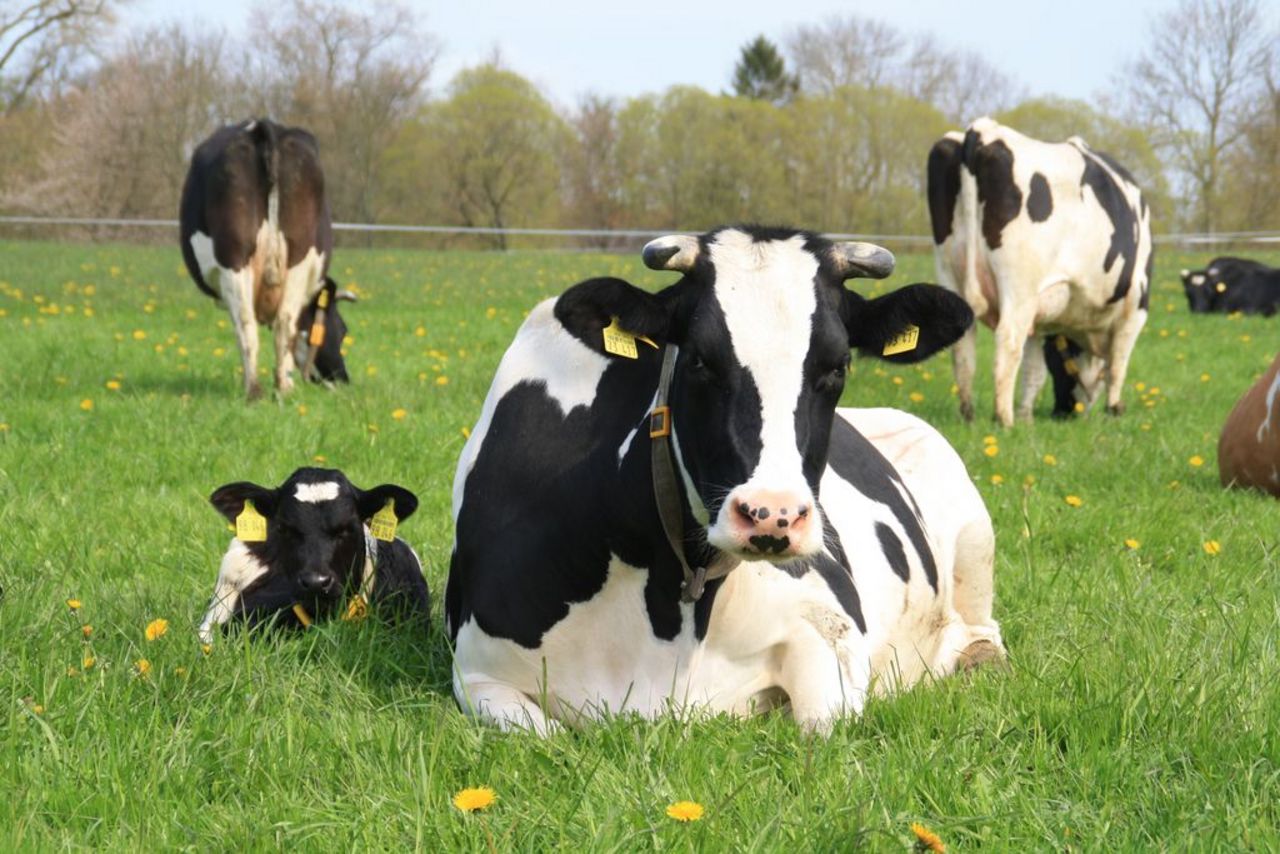Project
Milk & Calf – Marketing of products from dairy farms practicing cow-calf-contact

More than a niche? The potential of dam rearing for marketing of milk and male calves
Some consumers ask for milk that is produced without separating cow and calf shortly after birth. We ask if dairy farmers will get more chances to market their products by dam rearing their calves.
Background and Objective
More and more consumers as well as animal rights organisations criticise repeatedly the early separation of cow and calf in modern dairy farming. Meanwhile, some dairy farms rear their calves by suckling at dam or foster cows and studies address the effects of cow-calf contact on animal health, performance and behaviour. Although positive effects on calves were detected, this rearing method reduces the amount of deliverable or processible milk. To be profitably, farmers thus have to gain higher prizes for their products – like milk or calves for fattening. However, until now information is lacking how milk and calves, which are produced in such systems, are market, and whether farmers use dam rearing as an argument in product marketing. The project will gain information concerning the acceptance as well as the refusal of such products along the whole processing and market chain. At the end, ideas of marketing strategies shall be developed which will be transferred back to the stakeholders of the whole value chain. All together a comprehensive picture of the potential of dam rearing will be gained.
Approach
In the first part of the project we address the issue how milk and calves, which are produced in dam rearing systems, are market, and whether farmers use dam rearing as an argument in product marketing. If possible, all German dairy farmers practicing dam rearing will be interviewed to reveal the status quo of production and marketing of milk and calves from dam rearing systems. In a second step, the awareness of dam rearing in dairies, cattle dealers and fattening farms will be inquired. As little is known about the pros and cons of dam rearing mainly qualitative analysis like semi structured interviews or expert interviews will be carried out. Finally, retailers and consumers will be surveyed. In case of consumers the survey will be based on the findings of the former interviewed stakeholders. A quantitative survey will be carried out and will contain closed and open questions.
Results
Links and Downloads
Thünen-Contact

Involved Thünen-Partners
Funding Body
-
Federal Office for Agriculture and Food (BLE)
(national, öffentlich)
Duration
1.2018 - 12.2020
More Information
Project funding number: 2815NA094
Funding program: Bundesprogramm Ökologischer Landbau und andere Formen nachhaltiger Landwirtschaft (BÖLN)
Project status:
finished
Publications
- 0
Barth K, Christoph-Schulz IB, Placzek M (2021) Kuhgebundene Aufzucht - bald keine Nische mehr? Top Agrar Spezialprogr Rindviehhalt(8):R8-R10
- 1
Barth K, Placzek M, Christoph-Schulz IB (2021) Mehr als eine Nische : Produkte aus kuhgebundener Kälberaufzucht. Trenthorst; Braunschweig: Thünen-Institut für Ökologischen Landbau; Thünen-Institut für Marktanalyse, 2 p, Project Brief Thünen Inst 2021/09, DOI:10.3220/PB1615975793000
- 2
Barth K, Placzek M, Christoph-Schulz IB (2021) More than a niche: Products from cow-calf contact systems. Trenthorst; Braunschweig: Thünen Institute of Organic Farming; Thünen Institute of Market Analysis, 2 p, Project Brief Thünen Inst 2021/09a, DOI:10.3220/PB1615976246000
- 3
Placzek M, Christoph-Schulz IB, Barth K (2020) Schlussbericht : Mehr als eine Nische? Untersuchungen zum Potenzial der kuhgebundenen Kälberaufzucht in der Vermarktung von Milch und männlichen Kälbern ; BÖLN-Förderkennzeichen: 2815NA094, Laufzeit: 01.2018 - 12.2020. Trenthorst; Braunschweig: Thünen-Institut für Ökologischen Landbau; Thünen-Institut für Marktanalyse, 56 p
- 4
Barth K (2019) Effects of a 3-month nursing period on fertility and milk yield of cows in their first lactation. In: Newberry RC, Braastad BO (eds) ISAE 2019 : proceedings of the 53rd Congress of the ISAE ; 5th - 9th August, 2019, Bergen, Norway ; Animal Lives Worth Living. Wageningen: Wageningen Academic Publ, p 85
- 5
Placzek M, Barth K (2019) So variabel wie das Haltungssystem : Vermarktung von Milch aus kuhgebundener Aufzucht. Milchpraxis 53(3):44-46
- 6
Placzek M, Christoph-Schulz IB, Barth K (2019) Status quo der kuhgebundenen Kälberaufzucht in Norddeutschland. In: Mühlrath D, Albrecht J, Finckh M, Hamm U, Heß J, Knierim U, Möller D (eds) Innovatives Denken für eine nachhaltige Land- und Ernährungswirtschaft : Beiträge zur 15. Wissenschaftstagung Ökologischer Landbau ; Kassel, 5. bis 8. März 2019. Berlin: Köster, pp 268-269
- 7
Placzek M, Christoph-Schulz IB, Barth K (2019) Vermarktung von Milch aus kuhgebundener Kälberhaltung : Posterpräsentation anlässlich der 59. Jahrestagung der GEWISOLA (Gesellschaft für Wirtschafts- und Sozialwissenschaften des Landbaues e.V.) "Landwirtschaft und ländliche Räume im gesellschaftlichen Wandel" Braunschweig, 25. bis 27. September 2019. GEWISOLA, 2 p
- 8
Barth K (2018) Effects of suckling on milk yield and milk composition in dam rearing systems. In: Proceedings of the Fifth Dairycare Conference 2018 : Thessaloniki, March 19th and 20th 2018 "Getting There". DairyCare COST Action FA1308 2018, p 28
- 9
Barth K, Placzek M (2018) Kuhgebundene Kälberaufzucht in der Praxis : es gibt kein Standardverfahren. Milchpraxis 52(3):58-61

![[Translate to English:] [Translate to English:]](/media/_processed_/8/e/csm_Bildschirmfoto_2021-03-03_bearb_fc48ac88bf.jpeg)
![[Translate to English:] [Translate to English:]](/media/_processed_/8/e/csm_Bildschirmfoto_2021-03-03_bearb_ba3ec0e9d7.jpeg)
![[Translate to English:] Logo des Bundesministerium für Ernährung und Landwirtschaft](/media/allgemein/logos/BMEL_Logo.svg)